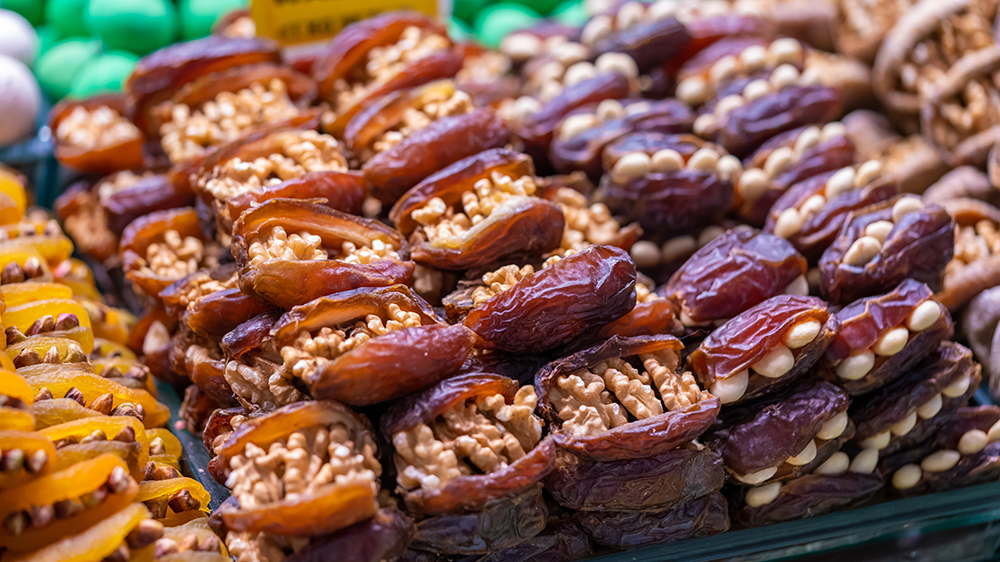Sometimes, perception can be like a flash of lightning that changes the world forever. Once something is seen and understood, there is no unseeing or unknowing. A few years back, I had such a food-related epiphany. I was in Istanbul and went into one of the many great food and spice shops that line the streets for some Iranian saffron to take back to the States as gifts. I greeted the proprietor, scanned the store for saffron, and became transfixed and the large display of cevizli in the center of the shop. The modern Turkish word, “cevizli,” means walnut, but is also used to refer to a class of snack or dessert-like dishes that blend any type of nuts with fruit in a wide variety of ways. Sort of like saying, “coke,” for any type of soft drink.
Sometimes fruits like dates or apricots are simply stuffed with nuts, with or without sugar or other ingredients. The nuts in cevizli could be walnuts, hazelnuts, pinenuts, or pistachios, or almonds, etc. Other times, nuts – sometimes accompanied by minced fruit – are wrapped in a dried fruit or wine-pomace skin, or in a more modern variant, in types of pastry. Sometimes crushed nuts are used as a coating as well. I had seen and enjoyed cevizli many times in the past, but at that moment, I realized that modern Cevizli ARE the ancient Mesopotamian confection known as mersu, and my food-world was forever changed.
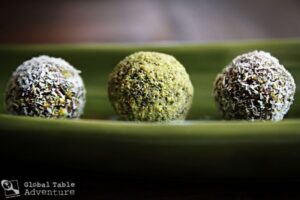
I’ve I’ve written about concepts of and recipes for mersu several times on the Silk Road Gourmet before. (For my previous posts on mersu, please click here and here.) To briefly recap those musings, throughout most of the 20th century, mersu was known only from tablets recovered from the ancient city of Mari by French archaeologists in the 1930s. The original description mentions only pounded dates, ground “flour” for a coating (ARM 11, 13: l and 124: 4) and a sort of nut that I think are pistachios (ARM 11, 13: 2). The simplest way to envision this as a dish would be as Sasha Martin did in my Ancient Mesopotamian Cookoff back in 2011: as pounded dates rolled into balls and coated with nuts.
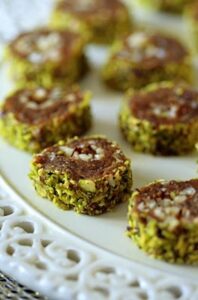
A fine flour (like semolina) could be added to help the ground nuts stick to the dates. Just as easily, the pounded dates could be used to make a flat surface on which nuts were placed and then rolled and sliced, as those featured to the right.
The concept of mersu changed dramatically in the late 1970s, when Marcel Siegrist published on the creation of food offerings for celebrations at the Temple of Nusku (light/fire) in Nippur (JCS 29, 1977). In this paper, Siegrist recounted the myriad of other ingredients that mersu could be made from. For example, in place of dates, figs, raisins, and another unspecified type of fruit, possibly a dried plum could be used. Other ingredients that could be used with or in place of the minced nuts in the body of the confection are minced apples. Still other ingredients listed include fat, cheese, and wine. These ingredients could actually be a thick, clotted cream like kaymak, yogurt cheese, and dried wine-pomace made into a fruit leather. Essentially, Siegrist’s paper lays out the concept of mersu as a diverse dish made in a, “One from column A, plus one from column B approach.” Kind of the way the variety in modern cevizli dishes are achieved.
Another interesting similarity between the two types of dishes is linguistic. Both words mersu and cevizli are used to denote a class of dishes that can be prepared from a wide variety of ingredients, in many different forms. This may seem like a big, “so what,” but it is significant because Semitic and Turkic languages are not closely related. The words cevizli and mersu are not related. So, it’s possible that with the food concept, came the language concept. At least in this case.
One thing we do not yet know is if the Mesopotamians cooked mersu in any way. Information from the tablets only list ingredients, not details on how to cook mersu. Modern cevizli can be baked, lightly braised on the stovetop in milk and sugar, or constructed raw. If mersu were cooked, my studies of ancient Mesopotamian cuisines suggest that they would probably be lightly braised in some liquid, because many other foods, including meats, are known to have been “boiled” in this manner.
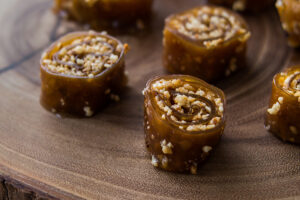 | 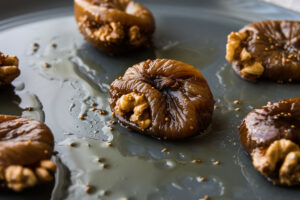 |
Some types of modern cevizli are shared by other countries in the region. Different forms of cevizli incir – figs or dates stuffed with nuts are also known east into Iraq and Iran, and all over the Arabian Peninsula and into northern Africa. But the most spectacular example of this is how cevizli sucuk – strings of nuts (usually walnuts) are coated with layers of fruit or wine-pomace syrup and dried – are also found in Georgia and Armenia as churchkhela. A delicious and nutritious snack, often considered a “traveler’s food,” for long journeys on the Silk Road no doubt.
My realization that the Ancient Mesopotamian confection of mersu was alive and well on the streets of Istanbul not only rocked my food world. It forged an unbreakable link between the past and the present for me. Mersu are no longer known only from tablets or academic papers by ancient near-east scholars, or as food of an ancient royal court, or offered to gods, but rather from men, women, and children – ordinary people – enjoying cevizli as part of their everyday lives.
The recipe below is for a delicious modern, baked cevizli: Baked Dried Apricots with Walnuts (cevizli kuru kayisi tatlisi) that has been graciously shared by Ozlem Warren, author of Ozlem’s Turkish Table.
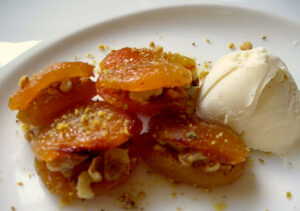
Ingredients
- 225 gr / 8 oz dried Turkish apricots
- 3 fl oz / ⅓ cup water – if needed –
- 30ml/2 tablespoons butter
- 30ml/2 tablespoons brown sugar
For the filling:
- 75 gr /1/2 cup crushed walnuts into small pieces
- 50 gr / ¼ cup brown sugar
- ½ cup water for baking
- Crushed pistachio nuts for garnish
Instructions
- Preheat oven to 180 C/ 350 F
- Soak the dried apricots in warm water for 10 minutes, if they are really hard. Then drain the water. If they are already soft enough to split open, you can skip this step.
- Combine the crushed walnuts and brown sugar in a small bowl for the filling.
- Split open the apricots with a small knife, making sure one end is still intact.
- Stuff each apricot with a teaspoonful of crushed walnut and brown sugar mixture and slightly close it up.
- Grease a baking tray with olive oil or butter and place the stuffed dried apricots on it.
- Pour the water over the tray.
- Place a tiny little dab of butter on the top of each stuffed apricot.
- Sprinkle 2 tablespoons of brown sugar over the apricots and bake in the oven for 25 minutes.
- Arrange them in a serving dish and sprinkle over some crushed pistachio nuts.
Words and Observations by Laura M. Kelley
Photo Credits: Cevizli Incir, ID 123319067 © Arissuu1 | Dreamstime.com; Mersu, Variant 1, Sasha Martin; Mersu, Variant 2, by Kate/Kajal, Aaplemint; Cevizli Sucuk, ID 78938594 © Alp Aksoy | Dreamstime.com; Walnut Stuffed Figs, ID 100909606 © Coskun | Dreamstime.com; Dried Apricots with Walnuts, Oslem Warren/ Ozlem’s Turkish Table.

